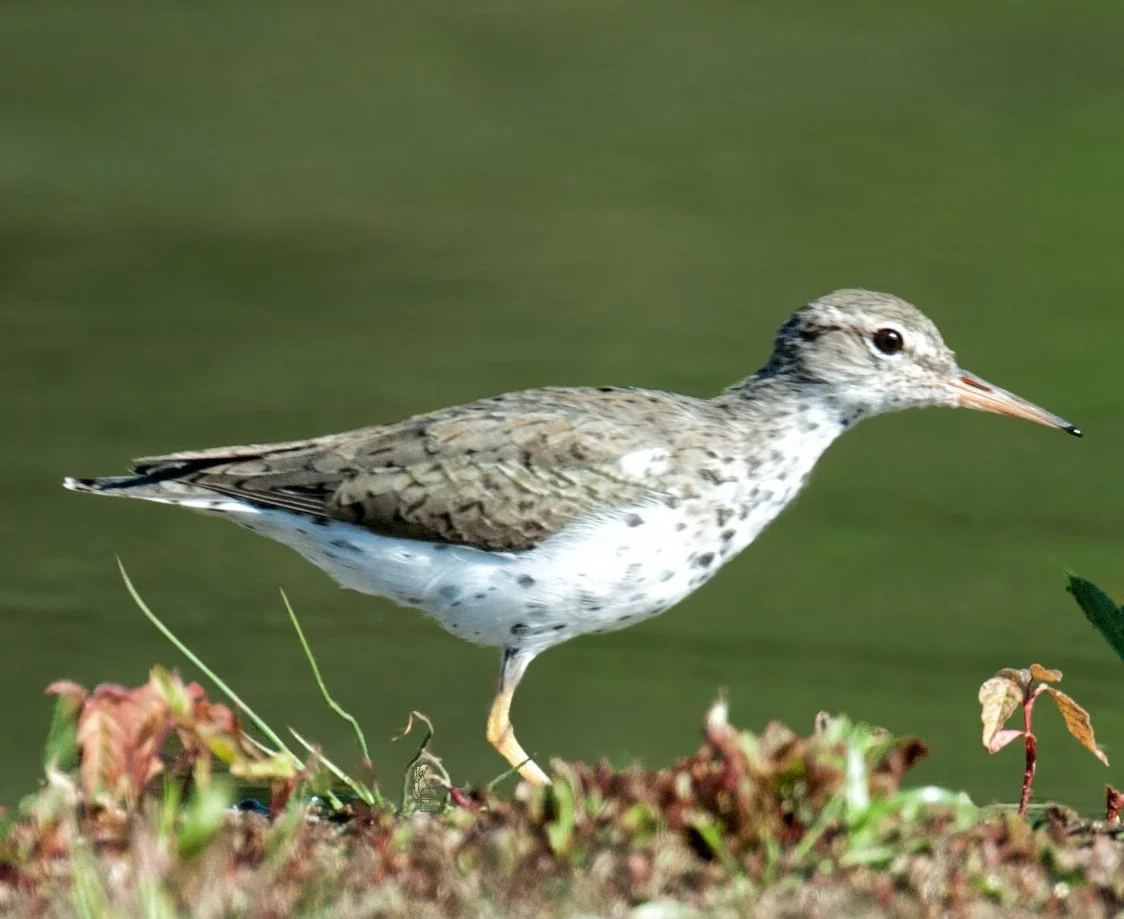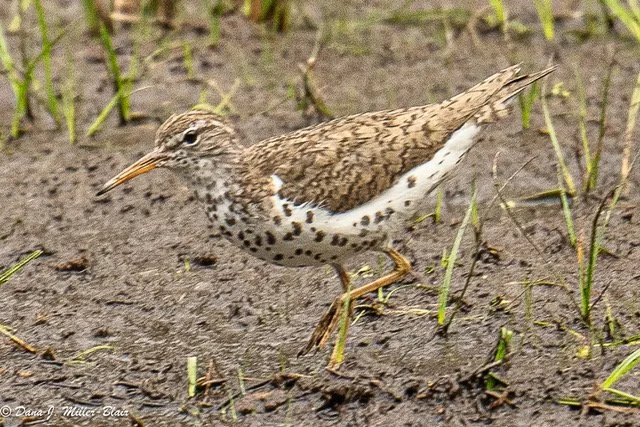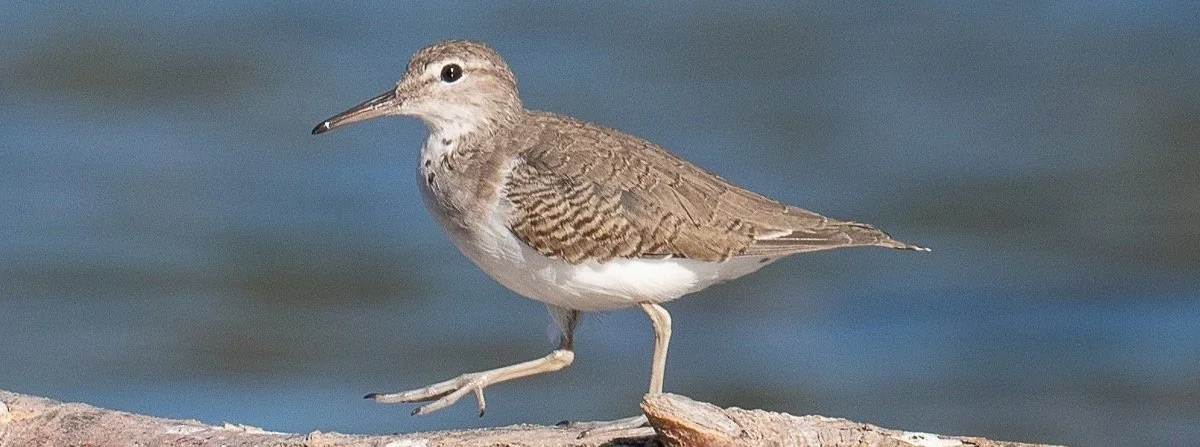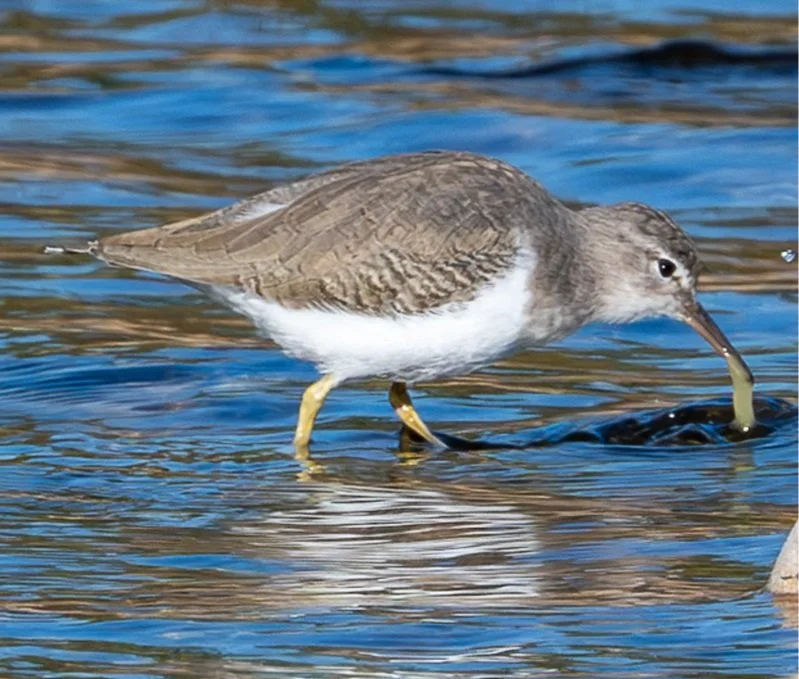This month let’s learn about a unique shorebird that’s found across North America, called the Spotted Sandpiper (Actitis macularius). Spotted Sandpipers are the most widespread sandpiper in North America. Their range is throughout North and Central America and includes the western Caribbean Islands. They are rare visitors to Europe, Russia, Siberia, and a few Pacific Ocean islands. Spotted Sandpipers are found at elevations from sea level to 15,400 feet. However, according to the North American Breeding Bird Survey, populations of Spotted Sandpipers from 1966 to 2019 declined yearly which resulted in a total decrease of around 54%. Habitat loss is most likely the major cause of this decline and is due in part to wildfires. Fortunately, Spotted Sandpipers can adapt to many environmental changes and pressures.
Spotted Sandpipers are usually solitary birds. Sometimes there will be a few of birds in close proximity; but as a rule they are not seen in flocks. A helpful clue used to identify this species is that their rear ends are almost constantly bobbing up and down in a teetering or see-saw motion. Click here to see a video of a Spotted Sandpiper bobbing its tail. Even hatchlings exhibit this behavior. Additional clues for identification are that Spotted Sandpipers appear to lean forward when they walk and during flight they hold their wings stiff. They fly (often fairly low) using rapid wingbeats followed by glides. They glide with their wings held in a fixed, downward curved position. Spotted Sandpipers will sometimes perform a display when threatened by positioning their bodies upright and their bills forward, extending their wings outward and upward, raising their breast feathers, opening their bills, and fanning their tails!
In spring and fall, most populations of Spotted Sandpipers migrate long-distances. The exception is those that live year-round along the west coast of the U.S and in some inland regions of California. In these areas, they may be short-distance migrants. Breeding locations in the Sacramento Valley were first documented in the 1970’s. Spotted Sandpipers migrate both day and night; either alone or in small groups. This is interesting because most other shorebirds migrate in large flocks.
What do Spotted Sandpipers look like?
Spotted Sandpipers get their name from the dark spots that appear on their white breast and belly during mating season. In addition, during the mating season, a pattern of brown and light brown is more distinct on their backs, wings, and heads. When breeding season ends, the breast and belly of adult birds gradually change to plain white. This occurs when Spotted Sandpipers molt (shed feathers so new ones can grow in). They also lose the patterning on their upper parts, becoming a solid brown. Their short, straight, yellow or reddish-orange bills also change appearance in mating season. When breeding the tip of the bill is black, this changes to tan or brown in winter. A broken white eye-ring, white supercilium (the line running across the top of the eye), and dark eyestripe below the supercilium are present year-round. When flying, Spotted Sandpipers have a noticeable white stripe on their upper wings (view photo here) and a white area under their wings (view photo here).
Spotted Sandpipers are commonly confused with the similar Solitary Sandpiper. One distinct difference is a white wedge-shaped area on the Spotted Sandpiper that extends from the belly into their shoulder region. Refer to the photos above. The Solitary Sandpiper does not have this. You can see a picture of a Solitary Sandpiper here. You can also find images of other shorebirds found in the Sacramento Area in our Gallery of Birds and learn more about what shorebirds are found in our area at what times of year by checking out the Sacramento Area Birds Checklist.
Where do Spotted Sandpipers live and nest?
Throughout the seasons, Spotted Sandpipers are found in various habitats such as forest, scrub forest, rainforest, chaparral, savanna, grassland, gravel pits, coastal shores, and mudflats. You may think an ocean beach would be the best place to find a shorebird such as a Spotted Sandpiper. However, it’s more common to see this species of shorebird near fresh water than salt water. Spotted Sandpipers are found most often when walking or hopping along edges of rivers, lakes, streams, marshes, creeks, ponds, and other inland waterways. It’s mainly in winter that they are seen along ocean coasts and in mudflats. There are some great places to find Spotted Sandpipers locally, such as the parks along the American River Parkway or on the edges of Folsom Lake.
The nesting range of Spotted Sandpipers is vast and stretches from northern Alaska and Canada across most of the North American continent to the southern United States. In contrast, most other sandpiper species nest solely in arctic regions. Spotted Sandpiper nest sites are commonly found in forested areas near rivers or lakes but they can also be found in grasslands, forests, fields, lawns and parks, and other habitats where there is a body of water. In winter, Spotted Sandpipers can be found in most any habitat where water is present. They spend their winters along the Pacific Coast south from British Columbia and across the southern states south to South America.
The nesting behavior of Spotted Sandpiper pairs varies from region to region. In many regions, females spend the majority of their time defending their nesting territories while males concentrate on caring for the young. These duties are reversed in most other bird species in general. Because Spotted Sandpiper females often arrive at nesting locations before males do, they often choose the nesting sites. Both males and females help to build nests. Nests are usually within 300 feet of the water’s edge under trees or shrubs so that there is shelter for the hatchlings. The nest sites are simple depressions on the ground lined with grass, moss, and sometimes feathers. In some regions, females lay eggs at more than one nest site. A different male will attend to each clutch of eggs. Although males can be territorial too, females exhibit extremely aggressive behavior when they feel their nesting territories are threatened. Sometimes, a less aggressive tactic is used to lure predators away from the nests, called Broken Wing Display. After dropping low to the ground, a parent will pretend to be injured by flapping its wings and spreading its tail.
When the Spotted Sandpiper chicks hatch, they are covered with downy feathers and their eyes are wide open. They walk with a steady gait soon after hatching and will begin foraging (hunting for food). At 3-5 days, they will start to stalk moving prey. Chicks are able to fly a good distance by 18 days.
What do Spotted Sandpipers eat?
Spotted Sandpiper catch their prey by pecking at visible insects on the ground or in shallow water, grabbing insects in flight, lunging at moving prey such as small fish, or picking insects and spiders off plants. They also sometimes poke their bills into sand or mud in search for food and will occasionally swim and dive for prey. Their diet includes almost anything that is small enough for them to eat. One source described them as “opportunistic carnivores”. They eat insects, crustaceans, occasionally small fish, and dead animals (or carrion). Included on their list of acceptable foods are: flies, fly larvae, grasshoppers, spiders, crickets, beetles, caterpillars, worms, snails, small crustaceans (crabs and crayfish), mollusks, and small fish. Often Spotted Sandpipers will dip their prey into water prior to ingesting it; but the reason for this behavior is uncertain. Females eat larger quantities of food in the breeding season due to their high metabolic energy usage when laying eggs. Chicks feed themselves as they walk and peck at the ground in search of soft-bodied morsels.
What do Spotted Sandpipers sound like?
One often hears a Spotted Sandpiper’s two or three note call when they take off from a shore. Listen also for their piercing high-pitched whistle alarm call along shores when they are warning a threat to stay back.
Their vocalizations have been described as a clear and abrupt peet-weet; or weet, weet, weet, or peet weet weet and also as a soft trill. Their alarm call is a repeated whistle pweet, pweet and their display song is a rolling, clear, whistled tototowee, tototowee. You can listen to the Spotted Sandpiper now.
The sounds of Spotted Sandpipers are from xeno-canto.org. More Spotted Sandpiper vocalizations can be found at: https://xeno-canto.org/species/Actitis-macularius.
This article was compiled by Jane Van Kessel.
Sources include Cornell Lab’s All About Birds and Birds of the World, 150 Frequently Seen Birds of California’s Great Valley, page 93, Sibley Birds West: Field Guide to Birds of Western North America, Second Edition, page 129, by David Allen Sibley, National Geographic Field Guide to the Birds of North America, 2017 edition, page 180, Kaufman Field Guide to Birds of North America by Kenn Kaufman, page 182, eBird.org, NatureWorks New Hampshire PBS, Sacramento County Breeding Birds: A Tale of Two Atlases and Three Decades of Change by Edward R. Pandolfino, Lily A. Douglas, Timothy D. Manolis, and Chris Conard, page 91, National Audubon (online) Bird Guide, Wikipedia, Animal Diversity Web





